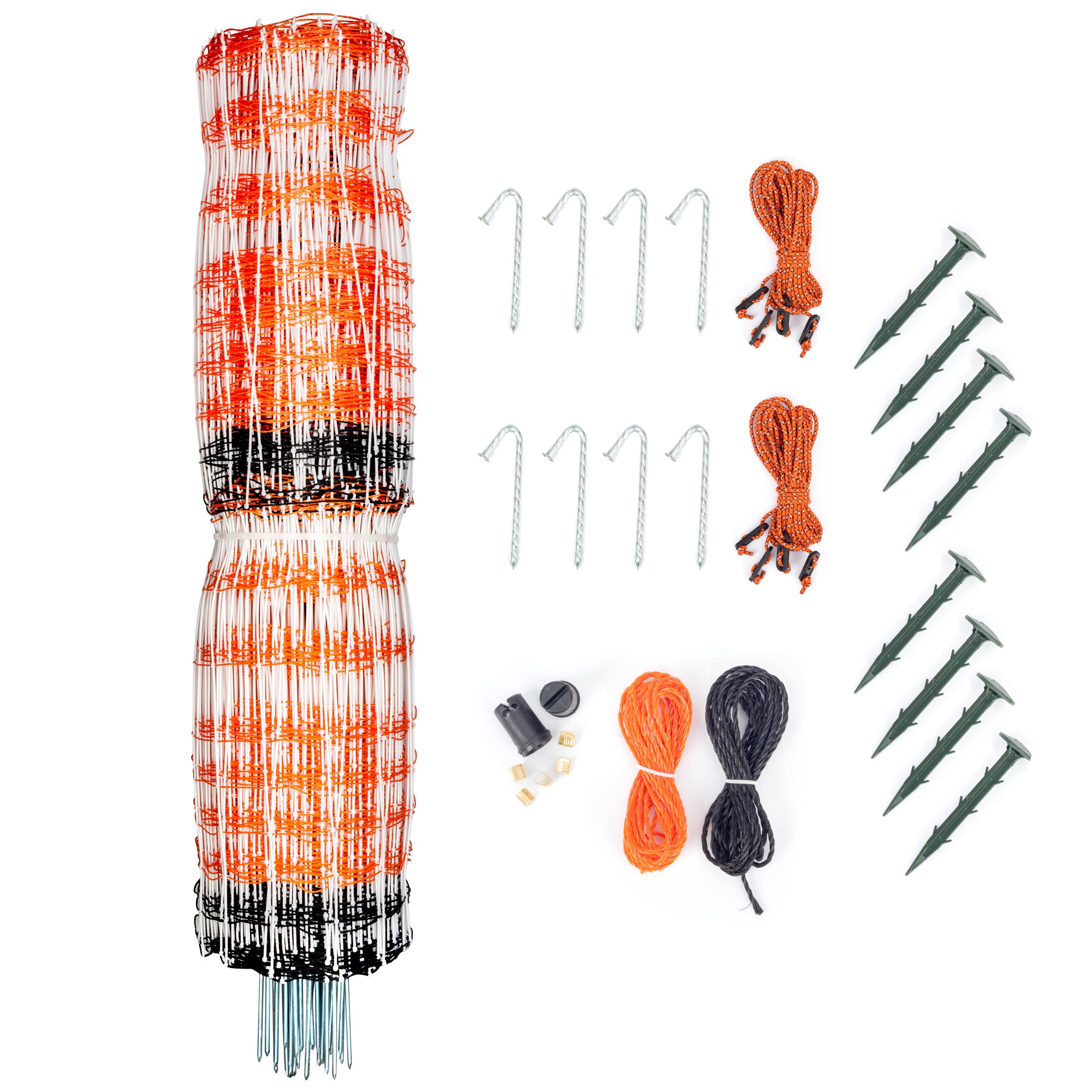Electric Net Fencing: Animal Training
Have you ever wanted an easy-to-use, flexible approach to handling your animals—whether they're a curious bunch of sheep or a busy flock of chickens? Electric netting fencing could be the answer you've been looking for! This innovative solution provides an inexpensive, portable, and safe way to keep your animals secure and curious predators out.
Whether you're a weekend hobbyist starting out in animal care, an experienced farmer, or a passionate pet owner, an electric net fence will surely come in handy.
This blog covers the following topics about electric net fencing:
- Training your animals: Know more about humane and practical ways to introduce your animals to the fence, ensuring a smooth and stress-free transition.
- Acclimatizing your animals: Understand the importance of gradual exposure and safety considerations during acclimatization.
- Common training issues and how to address them.
Tailoring Training to Different Animal Personalities
Animals can communicate in ways other than barking, meowing, and bleating. Successful and gentle training requires an understanding of the distinct behaviors and learning styles of various animals. Remember, there’s no one-size-fits-all approach when it comes to animal training. Each animal is unique, so personalize your training to their personality and learning style. Patience, good reinforcement, and understanding of their natural tendencies are essential for creating a happy connection with the electric net fence!
Sheep
Sheep have strong herding instincts, and respecting borders comes naturally to them. Introduce them to the fence gradually within a familiar enclosure. Make use of the flock mentality by leading one sheep through first, encouraging others to follow.
Poultry
Be especially cautious around these inquisitive creatures. Before exposing them to wider settings, start with a tiny, confined area with a low-power fence. Provide food and water sources inside the gated area to divert their attention.
Horses
These intelligent creatures need to be respected and communicated with clearly. Introduce them to the fence alongside another calm horse for reassurance. Use your body language and verbal cues to lead them, encouraging calm behavior
Goats
Goats are adventurous and require clear boundaries and enrichment. Begin with a tiny, low-power system and provide appealing toys or food within the gated area. Reward calm behaviors and discourage fence testing with firm, non-physical reprimands.
Dogs
Positive reinforcement such as treats, praise, and play works best for canines. Start with low-power fence introductions, gradually increasing the power as they gain confidence. Use verbal cues such as "watch the fence" and reward them for desired behavior.
Cats
Self-sufficient felines require a more patient approach. Use catnip sprays or goodies near the fence to reinforce a favorable association. Allow them to investigate at their own pace and avoid forceful interactions.
Bonus Tip: Consider using visual aids like coloured streamers or flags on the fence to enhance visibility for some animals, especially poultry.

Introducing Animals To Electric Netting Fencing
Once your electric netting fence is set up, it’s time to introduce your animals to their new boundary. Here's a step-by-step guide to ensure a smooth introduction and a stress-free transition for everyone involved.
Safety First!
- Ensure the fence is completely deactivated before introducing animals. Make sure the power is turned off. Making a double-check won’t hurt!
- During the whole process, stay close and watch your animals. Be ready to step in if you need to.
- Start with a short section of the fence, gradually expanding as your animals become comfortable.
- Create a calm and reassuring environment, avoiding loud noises or sudden movements.
Tips For Introducing Net Fencing
- The best time to make the introductions is when your animals are fed and calm. Stay away from stressful events like feeding time or trips to the vet.
- To get them to come closer, put treats or familiar things just inside the fence.
- Your animals should be able to touch the fence gently with their noses or paws. This helps them understand the barrier without experiencing a shock.
- Don’t underestimate the power of positive reinforcement. When they interact calmly with the fence, reward them with praise, treats, or playtime.
- Give your animals time to get used to the new fence by slowly increasing its length and strength over several sessions, giving them time to adjust.
The Power of Positive Reinforcement in Electric Net Training
Forget about coercive approaches and harsh corrections! When it comes to exposing your animals to electric net fences, enthusiasm and optimism are key. This technique not only promotes a positive and trusting relationship but also results in faster and more successful training. Let's look at how positive reinforcement might transform your fence into a welcoming boundary rather than a feared barrier or obstacle.
Why Positive Reinforcement Wins
- It builds trust and confidence as animals learn to connect the fence with positive experiences, which makes them less scared and anxious.
- Encourages desired behaviors because desired behaviors are rewarded, motivating them to repeat those behaviors consistently.
- Speeds up learning: A positive and stimulating learning environment leads to faster understanding.
- Strengthens bonds: The positive things that happen during training help to create a stronger tie between you and your pet.
Knowing what really motivates your animals might help you unlock the secrets to effective training. You can help them learn to navigate their new electric net environment while also developing a happy, trusting bond together.
Don't be scared to experiment and try new things! Give them a range of goodies, praises, or playtime to find their ultimate reward. Always remember that timing is everything. The quicker the reward follows the desired behavior, the stronger the positive association.
Avoid getting stuck on treats! To keep them interested, vary the rewards sometimes to keep things exciting. Unwanted conduct can be redirected with a kind "no" or a change in tone. The desired action can then be prompted, and success can be acknowledged with a reward.
Acclimatisation And Safety
Introducing your animals to the electric net is only the first step. Next will be the important step of adaptation, which will make sure they are safe and comfortable within the limits for a long time.
Slow And Steady Always Wins
Slowly increasing the power is important for acclimatisation, which is the key to long-term safety and comfort. Think low and slow: trust grows, positive associations are created, and boundaries are respected without too much stress. There may be worries about shocks and getting used to the system, but don't worry; modern systems put animal health first with safe pulses and natural learning processes.
Addressing Common Training Issues
Table 1. Common Training Issues And Their Solutions
|
Training Issue/s |
Solutions |
|
Fear of the fence |
|
|
Escape artists |
|
|
Fence shyness |
|
Safety First!
Even though the fence is primarily for your animals, everyone's safety is the most important thing—follow handling protocols, ensure proper grounding, and address escape risks. Encourage calm interactions near the fence; remember, patience and observation are key.
- You should only touch the fence when it's off or when you’re wearing insulated gloves.
- For best performance and safety, make sure there is proper grounding.
- Check the fence often for damage or places where it's weak.
- To prevent animal escape, fill in any gaps or possible escape paths right away.
- Put up warning signs about the electric fence that people can see.
Key Takeaways
Proper training can help ensure your animals have a smooth and positive journey toward understanding and respecting their new boundaries. Remember, training is an ongoing process, not a one-time event. Be patient, celebrate small victories, and most importantly, have fun! As your animals gain confidence and comfort, you can gradually expand the fenced area, introduce new challenges, and unlock its full potential.
Here’s a recap of the key benefits of electric net fencing:
Versatility
This system can be used with various pets and livestock. Electric net fences offer secure and flexible management.
Cost-Effective Choice
Electric nets are more affordable than traditional fence options, making them easily available to pet owners, hobbyists, and farmers.
Portability
Do you need to move your fence location? Not a problem! Electric nets are easy to load and set up. And they adjust to changing needs and seasonal grazing rotations.
As experts in the field of animal health and safety we highly recommend you check out the Pet Control HQ Electric Netting Fence.






